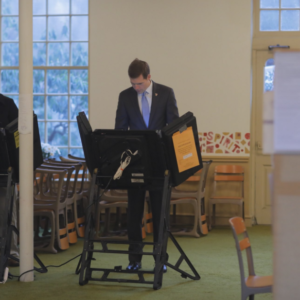American politics are shifting. We saw it on the big stage when Clinton lost to Trump in 2016, and we saw it a again on a smaller stage this month when Republican Rick Saccone lost to Democrat Conor Lamb in a special election to fill Pennsylvania’s vacant 18th Congressional District seat. Well-established alliances are fading, and while the major parties’ leaders drift ever further to ideological extremes, voters seem interested in a return to the pragmatic center.
As the 2016 presidential race was Clinton’s to lose, so too was Pennsylvania’s 18th District for Republicans. To say the 18th was a Republican district is an exercise in understatement; Donald Trump carried it by 20 points in 2016. Before resigning in disgrace, Republican Tim Murphy held the seat for 15 years, running unopposed in 2014 and 2016.
But the special election was tight. Conor Lamb won by fewer than 1,000 votes with 225,000 votes cast. Given the district’s history, it shouldn’t have been close to being close. A perfect storm of anti-Trump sentiment, a weak Republican candidate, and a Democrat who was willing to buck his own party to move to the center tipped the scales.
Republican Saccone’s fundraising was lackluster, and he was more than a little tone-deaf in proclaiming that he was “Trump before Trump was Trump.” By the final days of his campaign, Trump himself was referring to Saccone as a “weak candidate.” Even visits by the president and vice president could not put him over the top. The 18th’s voters have long leaned right, but in a choice between “more right” and “more center,” they chose the center. Yet Saccone is only half the story.
As much as Saccone embraced Trumpism, Democrat Conor Lamb distanced himself from the Pelosi-Schumer wing of his own party. House Speaker Paul Ryan referred to Lamb as a “pro-gun, anti-Nancy Pelosi conservative.” White House spokesman Raj Shah went so far as to say that Lamb “really embraced the President’s policies and positions.” This was actually not far from the truth given Lamb’s positions on guns and abortion, and his support of Trump’s recently announced tariffs.
Pundits have pointed to Pennsylvania-18 as the harbinger of a coming wave of Democratic election victories. This is likely true, though it’s common for the party opposite a recently elected president to gain seats in off-year elections. The importance of this race runs far deeper than that. It shows that the American people are becoming increasingly disenchanted with how both parties are being run.
The lesson is that the American people are not particularly thrilled with Republicans or Democrats, and maybe it’s time that the major parties did some soul searching. Do they represent large swaths of the American electorate? Or have they become caricatures of their former selves, playing a game of tit-for-tat that the American people now see right through?
The most recent presidential election, and now the Pennsylvania-18 special election, indicate it is the latter. In 2016 across America, voters who didn’t want either extreme chose what they perceived to be the lesser of two evils. Now, in Pennsylvania, a solidly Republican district chose a centrist Democrat over an extremist Republican.
From Clinton’s doubling-down on her claim that people on the right are “deplorable” to President Trump’s calling people on the left “treasonous,” elites of both parties have attained power by playing Americans against one another. But the American people are demonstrably tired of the politics of division. In the end, Pennsylvania-18 may be less a harbinger of change from Republican to Democratic than of change from extremism to moderate centrism. And that will be a welcome change.

